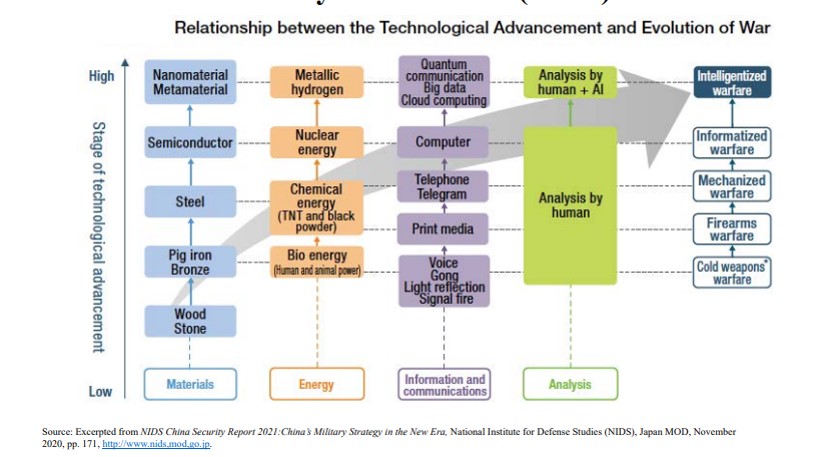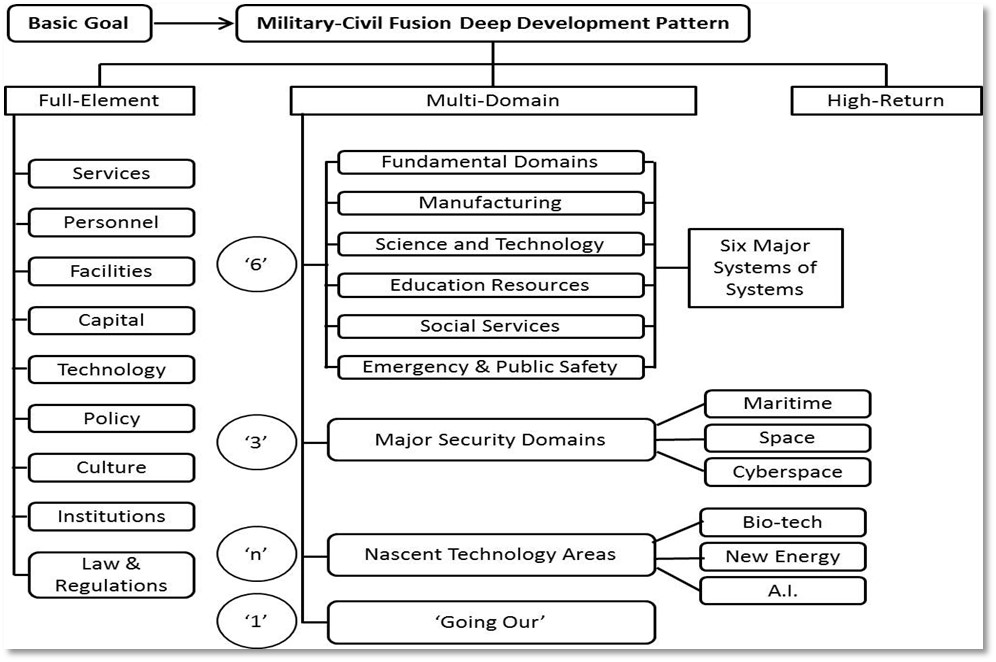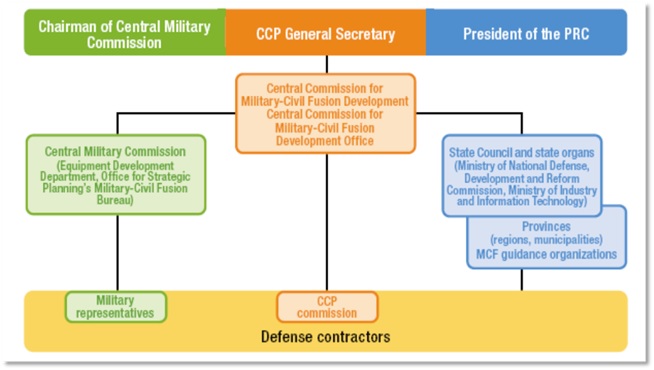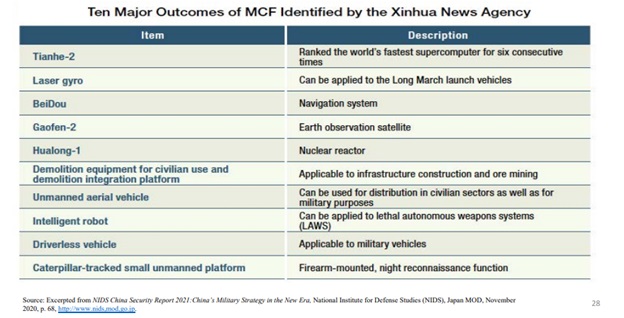

“We must accelerate the formation of a full-element, multi-domain, and high-return military-civil fusion deep development pattern, and gradually build up China’s unified military-civil system of strategies and strategic capability”, - Xi Jinping, speaking to the Central Commission for Military-Civil Fusion Development, June 20, 2017.
Military-Civil Fusion (MCF) is an aggressive national strategy of the Chinese Communist Party (CCP). The CCP pursues its MCF Development Strategy to fuse its security, economic and social development strategies to build an integrated national strategic system and capabilities. The Party’s leaders see MCF as a vital element of their strategy for China to become a “great modern socialist country” which includes developing a “world-class” most technologically advanced military and becoming a world leader in science and technology (S&T). To achieve this, MCF will allow the seamless flow of knowledge, technology, resources, materials and talent back and forth between the military, defence industrial sectors and academia. Its objectives are to develop and acquire advanced dual-use technology for military purposes and deepen reform of the national defense science and technology industries to strengthen all of the PRC’s instruments of national power. The CCP is executing this strategy through its own research and development efforts and acquiring the world’s cutting-edge technologies, including theft.
China’s MCF development strategy encompasses six interrelated efforts:-[1]
The Science of Military Strategy states, “In light of the ambiguous boundaries between peacetime and wartime in cyber countermeasures, and the characteristic that military and civilian attacks are hard to distinguish, persist in the integration of peace and war in military–civil integration; in peacetime, use civilians to hide the military; in wartime, the military and the people, hands joined, attack together.”[2] China’s concept and national strategy of military civil fusion stress leveraging synergies between defence and commercial developments. It also wants to utilise the skills of civilian personnel for force development. PRC President and CCP General Secretary Xi Jinping personally supervises the strategy’s implementation. He chairs the CCP’s Central Military Commission (CMC) and the Central Commission for Military-Civil Fusion Development.

China is a keen observer of western, especially American, theories and practices. It has analysed U.S. concepts of Civil-Military Integration (CMI), third offset strategy, Public Private Partnership (PPP) and Defense Advanced Research Projects Agency (DARPA). After careful scrutiny of all these concepts, China arrived at the strategy of Military-Civil Fusion. MCF caters to China’s specific conditions, requirements and goals.
The term MCF looks like the opposite number to the American term CMI. However, it is far deeper and more complex. As per the U.S. Congressional Office of Technology Assessment, America’s CMI is “cooperation between government and commercial facilities in research and development (R&D), manufacturing, and/or maintenance operations.”[3] But China’s MCF strategy is a state-led, state-directed program that leverages the state and commercial power to strengthen and support the People’s Liberation Army (PLA), the Communist Party of China's armed wing. In the American ecosystem, the level of integration has emerged over the decades. In China, MCF is a state-driven strategy for rapid implementation. The full scope of MCF is much broader than the public-private partnerships the Pentagon has been promoting.
Chinese scholars feel that MCF is not a new thing. They note that the developed nations promote MCF in the following ways:-
There are striking similarities between U.S. and Chinese organisations. The new Chinese CMC Science and Technology Commission resembles the DARPA. ‘Rapid response small group’, established by the Commission is reported in Chinese media as ‘China’s DIUx’ (defence innovation unit) for innovation to improve the PLA's capability to leverage commercial technologies.
MCF is critical for advancing China’s regional and global ambitions. A U.S.-China Economic and Security Review Commission report stated that the PLA “is heavily reliant upon China’s commercial IT sector to aid research and development into dual-use and military-grade microelectronics and telecommunications and to improve the military’s C4ISR capabilities.” At an address in the annual parliamentary session, Chinese President Xi Jinping called for deepening civil-military fusion while emphasising technical innovation's strategic importance for the PLA’s military modernisation, including training, recruitment, weapons innovation and strategic planning. He said, “Military innovations should take a central role in producing indigenous military wares; and that the governments from the state to the local levels should promote integration between the civilian and the military sectors.”
Key technologies that are targeted Under MCF include quantum computing, big data, semi-conductors, 5G, advanced nuclear technology, aerospace technology and artificial intelligence. China especially wants to exploit the inherent ‘dual-use’ nature of many of these technologies, which have both military and civilian applications. China is developing and acquiring niche technologies through licit and illicit means. These include investment in private industries, acquiring intellectual property, talent recruitment programs, academic and research collaboration programs for military advantage, intelligence gathering, forced technology transfer and outright theft. MCF permits selected civilian enterprises to undertake classified military R&D and weapons production. China exploits the open and transparent nature of the global research creativity to bolster its own military capabilities through bodies like the China Scholarship Council. It requires academic scholarship recipients to report on their overseas research to Chinese diplomats.

MCF development can contribute to the following key positive results:-
The Communist Party in recent years has drastically cut back on its use of the term ‘military-civil fusion’. 14th Five-Year Plan Outline of 2021 omits the phrase entirely. In March 2021, 4th Session of the Thirteenth National People’s Congress passed the most important national strategy for China’s military industry, the ‘Outline of the 14th Five-Year Plan (2021-2025) for National Economic and Social Development and Vision 2035 of the People’s Republic of China’ (The 14th Five-Year Plan).[4] The 14th Five-Year Plan is the most important policy document for China’s social and economic development over the next five or even 15 years. It is highly relevant to the defense industry primarily by:-
Strengthening of the preparation for wars.
Including the augmentation and integration of informatization, mechanisation and smartness.
Emphasis on the strategic capabilities in defence of sovereignty, security and development interests.
Acceleration of weaponry and equipment modernization.
There is a focus on:-
This document is an upgraded version of China’s 13th Five-Year Plan (2016–20) which described the 2020 goal for MCF as “form a basic military-civilian science and technology collaborative innovation system, and promote the formation of comprehensive, multi-domain, and high-efficiency military-civilian technology fusion.” To ensure the completion of this objective, the plan charted following seven specific goals to:-[5]
The importance the CCP gives to MCF can be seen from the overall management and implementation of the MCF Development Strategy. It includes the most powerful organs in the party-state: the Politburo, the State Council and the CMC. The CCP Central Committee’s rise of the MCF Development Strategy to a national-level strategy is aimed to overcome hindrances to implementation across the party-state. The Central Commission for Military Civilian Fusion Development (CCMCFD) was established in 2017, chaired by General Secretary Xi Jinping, Premier Li Keqiang, several other Politburo Standing Committee members, two State Councilors, both CMC Vice Chairmen, 12 Ministry-level leaders, and others. The specified objective of the CCMCFD is to build China’s “national strategic system and capabilities” and overcome impediments to implementation.
The graphic below illustrates the core components of the military-civil fusion deep development pattern:-[6]

In the military, the Military-Civil Fusion Bureau was established in the Office for Strategic Planning of the CMC in 2016. This bureau is the driving force behind civilian participation in the defence industries. The State Administration for Science, Technology and Industry for National Defense (SASTIND), is the force behind “eliminating barriers to defence conversion.” SASTIND is responsible for the management of national defence company policy. Also, military representative offices have been established at each level as representatives of the PLA in defence contractors and other entities and are responsible for implementing contracts, monitoring quality control, receiving products and liaising with the military.

China pursues MCF through six interrelated efforts. Each effort overlaps with the others and has both domestic and international components. The Party seeks to implement the MCF Development Strategy across every level of China’s party-state from the highest national-level organs down to provinces and township. The six systems in the MCF Development Strategy are:-
Each MCF system has linkages between a number of organisations and government entities including:-
The Chinese government is promoting MCF by leveraging guidance funds as an important mechanism to drive capital and activities. For example, the military-civil fusion industrial development fund launched in September 2016 involved 30.2 billion RMB or $4.4 billion in its initial funding round. According to some estimates, the total funding for a wide variety of guidance funds is in the range of several hundred billion dollars. As of mid-2019, several billion dollars of funding has been allotted to MCF through funds launched in cities and provinces that include Shanghai, Sichuan, Guizhou, Hebei, Henan, Hunan, Guangdong, Zhejiang, Liaoning, Shaanxi and Heilongjiang.
Quietly, China has invested vast sums of money in Silicon Valley firms with technology relevant to national security. Crucial defence related targets include sensitive or military-grade equipment such as computer circuits, radiation-hardened programmable semi-conductors, accelerometers and military sensors, high-grade carbon fibre, restricted microwave amplifiers, proprietary and export restricted technical data and thermal imaging systems. Chinese investors are mainly involved in artificial intelligence, robotics, augmented reality/ virtual reality, and financial technology. It is estimated that China participated in 10-16 per cent of all venture capital deals, including 271 early-state technology investment deals worth $11.5 billion in 2015 alone. Examples are:-[8]
However, China maintains strict control over inbound investment.[11] Not all China’s technology companies are keen to pursue close collaboration with the PLA. Commercial considerations drive them in a fiercely competitive ecosystem. Those with international aspirations, like Alibaba, may tend to be less transparent about collaborations with the Chinese military and defence industry, with some important exceptions. Baidu, a global leader and member of China’s national team in artificial intelligence, and the China Electronics Technology Group Corporation have started a joint laboratory to apply artificial intelligence, big data and cloud computing to command and control measures.
To bring western innovations into its industrial ecosystem, China has increased its cyber and technology espionage activities. Such illegal transfers can occur through exports, foreign direct investment and acquisitions, cyber-espionage, traditional industrial espionage, research collaboration, talent acquisition, and influence operations. FBI Director Christopher Wray stated, "Over the past decade, the FBI has seen economic espionage cases with a link to China increase by approximately 1,300 per cent." There are many examples. PLA Navy submarines and frigates now have German-produced engines exported to China for commercial use.
The Australian Strategic Policy Institute estimates that the PLA has sponsored over 2,500 military scientists and engineers to study abroad, especially in 'Five-Eyes' countries (U.S., UK, Canada, Australia and New Zealand) since 2007. China's application of the MCF abroad threatens the democratisation of science and the philosophy of academic openness and collaboration.
China has intensified its regulatory actions deep into private Chinese enterprises to ensure they will function as arms of the state. It has renewed emphasis on technology independence. China provides massive subsidies for developing domestic technologies and support for ‘national champion’ firms designed to meet China's domestic technology needs and erode western multinationals' global market share.
China considers that the key to 21st century geopolitical and military competition lies with emerging technologies like artificial intelligence and machine learning, cyber, electromagnetic spectrum, quantum cryptography, swarm robotics and biotechnology. Currently, the U.S. dominates in these areas of international research and development. Remarkably, Chinese assessments of these technologies' criticality were significantly influenced by strategic thinking from within the U.S. government, especially the Department of Defence's Obama-era ‘Third Offset Strategy'.
The high-impact area of bio-technology is also identified as a MCF focus technology. Elsa Kania and Wilson Vorndick contended that the PLA is using MCF to ‘weaponize’ biotech such as the advanced biomimetic systems, CRISPR (Clustered Regularly Interspaced Short Palindromic Repeats) gene-editing technology, biological and biomimetic materials and human performance enhancement.[12] China is trying to leverage their Artificial Intelligence/Machine Language expertise to achieve its objectives through collaboration with foreign partners.
Chinese supremacy in 5G technology has alarmed the United States and others. Huawei, the world leader in 5G IT infrastructure, has substantial personnel overlap with the PLA. The U.S. is alarmed that the Chinese dominance in U.S. IT infrastructure would give the Chinese government access to colossal data about American companies and citizens. For several legal violations, including theft of trade secrets, and wire fraud, in January 2019, the U.S. State Department put Huawei on the Entity List.
China may have lost out on the Revolutions in Military Affairs (RMAs) of the early 1990s. Now it is determined to lead the era of the ‘Fourth Industrial Revolution’. Chinese strategic thinkers believe that artificial intelligence (AI) will drive the next revolution in military affairs, which the Chinese termed ‘intelligentized warfare’.

As China moves toward intelligentized warfare, MCF will be a crucial element of the PLA's overall strategy to achieve “complete military modernisation" by 2035 and become a "world-class" military by 2049. In July 2017, the State Council issued the AI Development Plan for a New Era, which stated that China will "promote the two-way transfer and application of military and civilian scientific and technological achievements, and jointly build and share the innovative resources of the military and civilian, to form a full-element, multi-domain, and high return military-civil fusion deep development pattern." This plan specifically attempts to "direct the results of AI technology toward defense applications and encourage civilian S&T researchers to participate in major national defense-related AI research."
The MCF strategy intends to break down the obstacles between the PLA, academia, technology and private sectors. This would facilitate the PLA to employ dual-use industries and technologies for military advancements and capabilities development.
The Central Military–Civil Fusion Development Commission, led by Xi Jinping, has made the Cyberspace Security Military–Civil Fusion Innovation Centre, Qihoo-360, a leading Chinese cybersecurity company. He is guiding the centre to improve national cyber defences. China wants to leverage 'cyber militias' for its cyber defence. Xi Jinping has continuously emphasised the dynamism and potential of MCF in cybersecurity and informatization, calling China to 'grasp the historical opportunity of the current information technology transformation and new transformation of military affairs'. In April 2018, in a speech delivered at the National Cybersecurity and Informatization Work Conference, Xi Jinping highlighted the inherent relationships between the market and the battlefield while 'promoting the creation of a full-factor, multi-domain and highly efficient development structure for MCF'.[13]
The PLA's Strategic Security Force (PLASSF) will have to keep pace with the rapid, disruptive technological changes, often driven by research and development in the private sector. These technological changes make SSF pursue civil-military integration fusion as an integral aspect of its mission. This involves taking advantage of dual-use technological advances and leveraging civilian talent. The PLASSF recruits a large number of civilian personnel as specialist professionals in cyber defence, aerospace and artificial intelligence. Individual PLASSF units are conducting research projects with universities. The quality of education at the SSF's Information Engineering University and Aerospace Engineering University will be crucial to its cultivation of personnel for command and technical career tracks.
SSF has been active in pursuing its goals of MCF. Some of the initiatives undertaken are:-
The complete Chinese university system is the front-line of MCF. The Chinese government certifies universities to conduct classified research and development on military matters. This policy is known in China as the 'three certifications'. Under this program, more than 80 Chinese universities have already been permitted to undertake Top Secret or Secret level military research and development. Many joint laboratories and research partnerships facilitate closer research cooperation between the military, defence industry, academia and commercial enterprises.
Tianjin's new AI Military-Civil Fusion Innovation Center was raised in partnership with the Academy of Military Sciences. Today it leads military science research for the PLA and defence innovation initiatives. In Beijing, the high-tech zone of Zhongguancun has focused on emerging technologies, including establishing new industrial parks and starting several projects such as robotics and intelligent equipment. Beijing Military-Civil Fusion Expo 2019 was organised to market commercial technologies to military users. New armoured, multipurpose drone launching vehicles capable of launching a dozen drones to conduct reconnaissance or even suicide attacks were displayed.
Though MCF could offer significant benefits to the PLA, some senior Chinese leaders, scholars and experts have underlined many internal challenges that will significantly translate the MCF policies against the realities. Although the CCP reigns supreme, many companies are reluctant to embrace MCF. They think that MCF will affect their ability to access foreign markets, and may put civilian companies out of the defence sector.
There are concerns about the lack of access to large-scale and high-tech facilities and experimental instruments for private sector companies. It is also unclear whether the private sector companies will get permission to work on very sensitive projects. On the other hand, some Chinese companies may try to take advantage of the resources available rather than provide real contributions to military modernisation. The heavy increase in funding, including the guidance funds dedicated to MCF, can aggravate corruption in the Chinese military and defence industry.
Though there has been noticeable progress in MCF, some experts are worried that, in their current state, the defence industrial base and the innovation base are not in a position to meet both defence and commercial needs. Another cause of worry is the defence industrial base's low self-sufficiency on the core, critical technologies and the innovation base's inability to produce original innovations and breakthrough technologies. Bi Jingjing, Deputy Commandant of NDU between 2012 and 2017, noted the following problems:-
The National Defense University of PLA observed that progress on the Development of Military-Civil Fusion in China had been unsatisfactory. The CCP had tried to pursue similar policies earlier without any success. Finding the balance between the role of the government and the market is and will be one of the toughest challenges in implementing the MCF strategy.
MCF is an aggressive national strategy of CCP. President Xi Jinping, since he took office, has been pressing hard on CMF and personally overseeing the strategy's implementation. He argued that there is a pressing need to transition from ‘early-state fusion’ to ‘deep fusion’, a process that had been held up by problematic mindsets, systemic barriers and vested interests. To effect change and drive results, Xi Jinping, at the first meeting of the Central Commission for Military-Civil Fusion Development on June 20, 2017, highlighted the task's urgency. He urged officials to "break down ramparts, break through solid ice, remove barriers…wade through dangerous shoals, move people's cheese, resolve difficult problems, overcome obstacles, try out new ideas and open new paths."[14]
[1]U.S. Dept. Of Defense, Military And Security Developments Involving The People's Republic Of China 2021, November 2, 2021 available at: https://china.usc.edu/us-dept-defense-military-and-security-developments-involving-peoples-republic-china-2021-november-2 [3]
[2]China, Academy of Military Science, Science of Military Strategy.
[3]China’s Military-Civil Fusion Strategy available at: https://www.airuniversity.af.edu/ [4] Portals/10/CASI/documents/Research/Other-Topics/CASI_China_ Military_Civil_Fusion_Strategy.pdf
[4]An archived version of the Chinese source text is available online at: https://perma.cc/3KWG-VCVC [5]
[5]The Thirteenth Five Year Plan’s Special Plan for Military-Civil Fusion Published], Xinhua, August 23, 2017 available at: http://www [6]. xinhuanet.com/mil/2017-08/23/c_1121531750.html
[6]Alex Stone and Peter Wood (2020), China’s Military-Civil Fusion Strategy: A View from Chinese Strategists, Montgomery, AL: China Aerospace Studies Institute, Air University available at https://www.airuniversity.af.edu/Portals/10/CASI [7] /documents/Research/Other%20topics/CASI%20 China’s%20Military%20Civil%20Fusion%20Strategy-%20Full%20final.pdf?ver=2020-06-15-152810-733
[7]http://www.nids.mod.go.jp/publication/chinareport/pdf/china_report_EN_web_2021_A01.pdf
[8]Paul Mozur and Jane Perlez, “China Bets on Sensitive U.S. Start-Ups, Worrying the Pentagon,” The New York Times, March 22, 2017 available at: https://www.nytimes.com/2017/03/22/technology/china-defense-start-ups.html [8]
[9]China’s Approval Process for Inbound Foreign Direct Investment: Impact on Market Access, National Treatment and Transparency available at: https://www.uschamber.com/sites/default/files/legacy/reports/020021_ [9] China_InvestmentPaper_hires.pdf
[10]Liana B. Baker, Koh Gui Qing, and Julie Zhu, “Exclusive: Chinese government money backs buyout firm’s deal for U.S. chip maker,” Reuters, November 28, 2016 available at: https://www.reuters.com/article/ [10] us-lattice-m-a-canyonbridge/exclusive-chinese-government-money-backs-buyout-firms-deal-for-u-s-chip-maker-idUSKBN13N1D5
[11]China’s Approval Process for Inbound Foreign Direct Investment: Impact on Market Access, National Treatment and Transparency, 2012 available at: https://www.uschamber.com/china%E2%80%99s-approval-process-inbound-foreign-direct-investment-impact-market-access-national-treatment [11]
[12]Elsa B. Kania and Wilson VornDick, China’s Military Biotech Frontier: CRISPR, Military-Civil Fusion, and the New Revolution in Military Affairs, Center for a New American Security, October 08, 2019 available at: https://www.cnas.org/publications/commentary/chinas-military-biotech-frontier-crispr-military-civil-fusion-and-the-new-revolution-in-military-affairs [12]
[13]Rogier Creemers, Paul Triolo and Graham Webster, ‘Translation: Xi Jinping’s April 20 Speech at the National Cybersecurity and Informatization Work Conference’, New America, 30 April 2018, available at: https://www.newamerica.org/cybersecurityinitiative/digichina/blog/translation-xi-jinpings-april-20-speech-nationalcybersecurity-and-informatization-work-conference [13]
[14]Alex Stone and Peter Wood (2020), China’s Military-Civil Fusion Strategy: A View from Chinese Strategists, Montgomery, AL: China Aerospace Studies Institute, Air University available at https://www.airuniversity.af.edu/Portals/10/CASI/documents/Research/Other%20topics/CASI%20China’s%20Military%20Civil%20Fusion%20Strategy-%20Full%20final.pdf?ver=2020-06-15-152810-733
(The paper is the author’s individual scholastic articulation. The author certifies that the article/paper is original in content, unpublished and it has not been submitted for publication/web upload elsewhere, and that the facts and figures quoted are duly referenced, as needed, and are believed to be correct). (The paper does not necessarily represent the organisational stance... More >>
Links:
[1] https://www.vifindia.org/article/2022/august/01/military-civil-fusion-in-china
[2] https://www.vifindia.org/author/maj-gen-p-k-mallick-1
[3] https://china.usc.edu/us-dept-defense-military-and-security-developments-involving-peoples-republic-china-2021-november-2
[4] https://www.airuniversity.af.edu/
[5] https://perma.cc/3KWG-VCVC
[6] http://www
[7] https://www.airuniversity.af.edu/Portals/10/CASI
[8] https://www.nytimes.com/2017/03/22/technology/china-defense-start-ups.html
[9] https://www.uschamber.com/sites/default/files/legacy/reports/020021_
[10] https://www.reuters.com/article/
[11] https://www.uschamber.com/china%E2%80%99s-approval-process-inbound-foreign-direct-investment-impact-market-access-national-treatment
[12] https://www.cnas.org/publications/commentary/chinas-military-biotech-frontier-crispr-military-civil-fusion-and-the-new-revolution-in-military-affairs
[13] https://www.newamerica.org/cybersecurityinitiative/digichina/blog/translation-xi-jinpings-april-20-speech-nationalcybersecurity-and-informatization-work-conference
[14] http://www.facebook.com/sharer.php?title=Military Civil Fusion in China&desc=&images=https://www.vifindia.org/sites/default/files/Untitled_47.jpg&u=https://www.vifindia.org/article/2022/august/01/military-civil-fusion-in-china
[15] http://twitter.com/share?text=Military Civil Fusion in China&url=https://www.vifindia.org/article/2022/august/01/military-civil-fusion-in-china&via=Azure Power
[16] whatsapp://send?text=https://www.vifindia.org/article/2022/august/01/military-civil-fusion-in-china
[17] https://telegram.me/share/url?text=Military Civil Fusion in China&url=https://www.vifindia.org/article/2022/august/01/military-civil-fusion-in-china